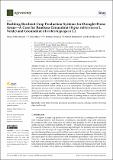| dc.description.abstract | Drought is a major crop production constraint worldwide. Some legume crops are known for their ability to resist water deficit stress. This study evaluated the responses of bambara groundnut (Vigna subterranea (L.) Verdc) and groundnut (Arachis hypogaea (L.) to soil water deficit stress. The experiment was set as a split-plot randomized complete block design. Three bambara groundnut landraces: viz DodR, NALBAM 4 and S19-3, and one groundnut variety, MNANJE, were assigned to subplots with three water regimes assigned to main plots (regime one: irrigated throughout the growing period, regime two: water deficit stress was imposed at the start of flowering to the end of first flush flowering, regime three: water was withheld during the pod development). Water deficit stress increased proline content by 123% in stressed plots. The highest (174%) and lowest (89%) proline increases were evident in the genotypes MNANJE and NALBAM 4, respectively. Water deficit decreased stomatal conductance, transpiration rate and photosynthetic rate, with MNANJE and S19-3 showing the smallest percentage decrease in most of the traits. This suggests that the two genotypes are drought resistant. The variations observed among landraces could be exploited to breed resilient varieties for cultivation in drought-prone areas, ultimately improving food security. | en_US |

